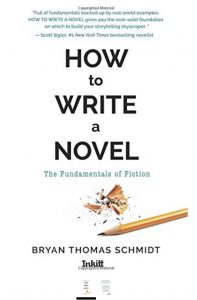 The following is an excerpt from my book How To Write A Novel: The Fundamentals of Fiction, Chapter 8:
The following is an excerpt from my book How To Write A Novel: The Fundamentals of Fiction, Chapter 8:
Techniques for Creating Suspense
So in addition to ratcheting up the tension every chance you get, what are some techniques to use to build suspense? The description of the bar above is a form of subtlety and misdirection known as foreshadowing. And foreshadowing is a technique all writers should use. Foreshadowing is presenting hints that will pay off in a bigger way later in a story.
For example, in Andy Weir’s smash hit novel The Martian, he sets up his protagonist, Mark Watney’s, background as a botanist to foreshadow later events:
In other news, I’m starting to come up with an idea for food. My botany background may come in useful after all. Why bring a botanist to Mars? After all, it’s famous for not having anything growing here. Well, the idea was to figure out how well things grow in Martian gravity, and see what, if anything, we can do with Martian soil. The short answer is: quite a lot… almost. Martian soil has the basic building blocks needed for plant growth, but there’s a lot of stuff go-ing on in Earth soil that Mars soil doesn’t have, even when it’s placed in an Earth-atmosphere and given plenty of water. Bacterial activity, certain nutrientsprovided by animal life, etc. None of that is happen- ing on Mars. One of my tasks for the mission was to see how plants grow here, in various combinations of Earth or Mars soil and atmosphere. That’s why I have a small amount of Earth soil and a bunch of plant seeds with me. I can’t get too excited, however. It’s about the amount of soil you’d put in a window planter-box, and the only seeds I have are a few species of grass and ferns. They’re the most rugged and easily grown plants on earth, so NASA pick-ed them as the test subjects. So I have two problems: not enough dirt, and nothing edible to plant in it.
Later on, Watney uses materials on the ship and in the environment to grow food and extend his life on the planet while he waits for rescue. In fact, his scientific calculations and knowledge become key to making rescue possible, but the timing for the mission becomes vitally important and dramatic. He has one shot at it and complications, of course, put the timing in jeopardy. What at first may seem like backstory on the character, becomes an essential plot elements. This is foreshadowing. A seemingly innocuous mention of science that might otherwise seem boring or useless foreshadows an important skill that will later save his life and be a hinge the story’s outcome depends on.
In my epic fantasy novel Duneman, I was creating a world where parts of the lands lived in medieval like conditions, while others had started industrial development, with steam powered airships, cranes, and more. Because the story starts in the medieval-like area, at one point, I had the protagonist pass airship landing zones on his journey, hinting that this land may seem medieval and standard fantasy but somewhere there are airships. It was subtle but later became important and set up the contrast between different areas of the lands, which in itself becomes an important source of conflict between various people groups—one that soon puts them on the brink of war. Always look for ways to hint at details early on which will play a key part later. If you don’t, readers will feel like you are inventing of necessity character skills and abilities or objects just when you need them for the story, which is manufactured and doesn’t ring true, and will shake their confidence and trust in you as a storyteller.
What if your characters hear a gunshot out on the street…discover a missing letter in the couch cushions…or smell an out of place odor in an unusual place? In Conflict, Action & Suspense, William Noble describes this technique as “plot-hypers.” Plot-hypers involve “injecting an unexplained event or circumstance” to add uncertainty or raise tension. Some are accomplished via misdirection and others through subtlety. He offers two classic examples.
In Arthur Conan Doyle’s Sherlock Holmes book The Hound of The Baskervilles, Sherlock discovers that a watch dog did not bark at a crucial moment, an odd coincidence. But at the end of the story, it becomes a significant clue that helps solve the case. This is subtlety.
In Edgar Allan Poe’s “The Purloined Letter,” a thief places an inoffensive letter next to a crucial one and then slyly slips away with the important one in front of witnesses. Police begins suspecting the thief because of his history and assume a search will turn up the letter, but the thief tricks them and hides it in plain sight. It almost works. This is misdirection.
Both involve one little fact that leads to an assumption. The authors don’t hit readers over the head. But yet the assumptions both take the story in surprising directions.
Another technique for setting up suspense is through flashbacks. Now, some people hate flashbacks. Flashbacks are scenes that take place earlier in a character’s history which reveal important information about the character, his or her relationships, or his or her conflict and flaws, which advance the story in their reveal. Admittedly, some authors overuse flashbacks, which can be annoying and also risks killing the pace of storytelling. Like any other scenes, flashbacks should be kept short and in media res applied. Enter and exit the scene as close to the key action as possible. Also be sure you introduce flashbacks only as needed vitally to further the story. Timing is key and when used well, flashbacks are an invaluable and quite effective tool for building tension and suspense in storytelling. The catch is that flashbacks can often slow the pace because they take us away from the main tension of the story and out of the present, pressing conflict to another time. For that reason, we will discuss them again briefly under pacing. But here’s an example from Miracle Man by David Baldacci, where a flashback actually continues the suspense and tension, despite interrupting a scene.
Decker has just posed as a lawyer in an attempt to get in to see a suspect at a police precinct—a suspect in the murder of his wife and child. As the woman at the counter asks him to sit and wait while she calls for approval, this happens:
Realizing he might have just blown a bunch of money he didn’t have on lawyer-looking attire, Decker sat down in a chair bolted to the wall and waited. The old woman picked up her phone and slowly, ever so slowly, punched in numbers. Numbers. Always numbers. They had a hypnotic effect on him, sending him to places he didn’t always want to go. Decker closed his eyes and his mind began to whir back…back to the day, no, the exact moment when his life changed forever. The crowd went berserk every time the hit was replayed on the megatron, and that was often, I was told later.My helmet flew five feet and rolled another six, end- ing at the feet of a zebra who picked it up and maybe checked inside to see if my head was still in there. I think my brain bounced against my skull multiple times like a bird trying to introduce itself to a window until its neck breaks. Yep, the crowd cheered and whooped whenever the mega- tron belched out the replay. Then I was told that they stopped cheering. Because I didn’t get up. Because I didn’t move a muscle. And then someone noticed I had stopped breathing and had also turned blue. They told me the head training was alternating pounding my chest like a punch press attacking metal slabs and blowing air into my mouth. Later, they told me I died on the field twice but he brought me back both times from the hereafter. They told me he was screaming in my ear, “Hang on, ninety- five. Hang the hell on.” I was such a nobody that he knew my jersey number but not my name. My professional football player identity was a nine and a five printed on my chest. Nine and five. Violet and brown in my counting colors mind. I never consciously assigned colors to numbers. My brain did it for me without my permission. The collision changed everything about me, because it essentially rewired my brain. So I died, twice, and then came back, essentially as someone else. And for the longest time I thought that would be the most awful thing that would ever happen to me. And then came that night and those three bodies in neon blue, and the gridiron blindside dropped to number two on the list of my personal devastations. “Excuse me, sir? Sir?” Decker opened his eyes to see the woman staring down at him.
Now that is a well-constructed flashback. Not only does he use telling language because Decker is recalling things that happened along with things others told him about them, but it interrupts the moment he has awaited for four long years: a chance to confront his family’s killer, yet still manages to maintain tension and suspense. That’s because every word drips with the character’s emotions and because Baldacci chooses the flashback placement well. It has everything to do with who Decker is and his intensity as a person and it even ties into the moment at the police station at the end. So, planned and written well, flashbacks too can be a device for upping suspense. We’ll talk about them more later. First, here’s yet another technique.



For example, what if a handsome man is cruel, a real jerk, or an evil character happens to have a soft heart for kids, who love and flock to him whenever he’s around? A church is corrupt and hides a criminal enterprise. A school teacher is engaged in selling students into sex slavery. All of these are twists on normal expectations that first occur to us, twists that surprise us by defying our natural assumptions. This is reversing the rules.
These four techniques are the most common tools for building suspense, but no doubt some of you—and other authors—can think of others I didn’t mention. The general rule is to use whatever works for you and betters your story and ignore what doesn’t. Also closely related to suspense is pacing—the flow of your story. It’s the combination of tension and suspense—keeping readers wondering, guessing, wanting to know what happens—that sets the pace of your story. We’ll examine that next.
